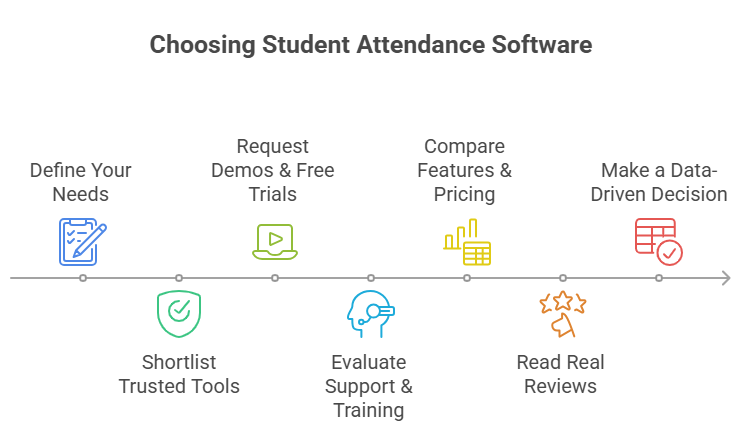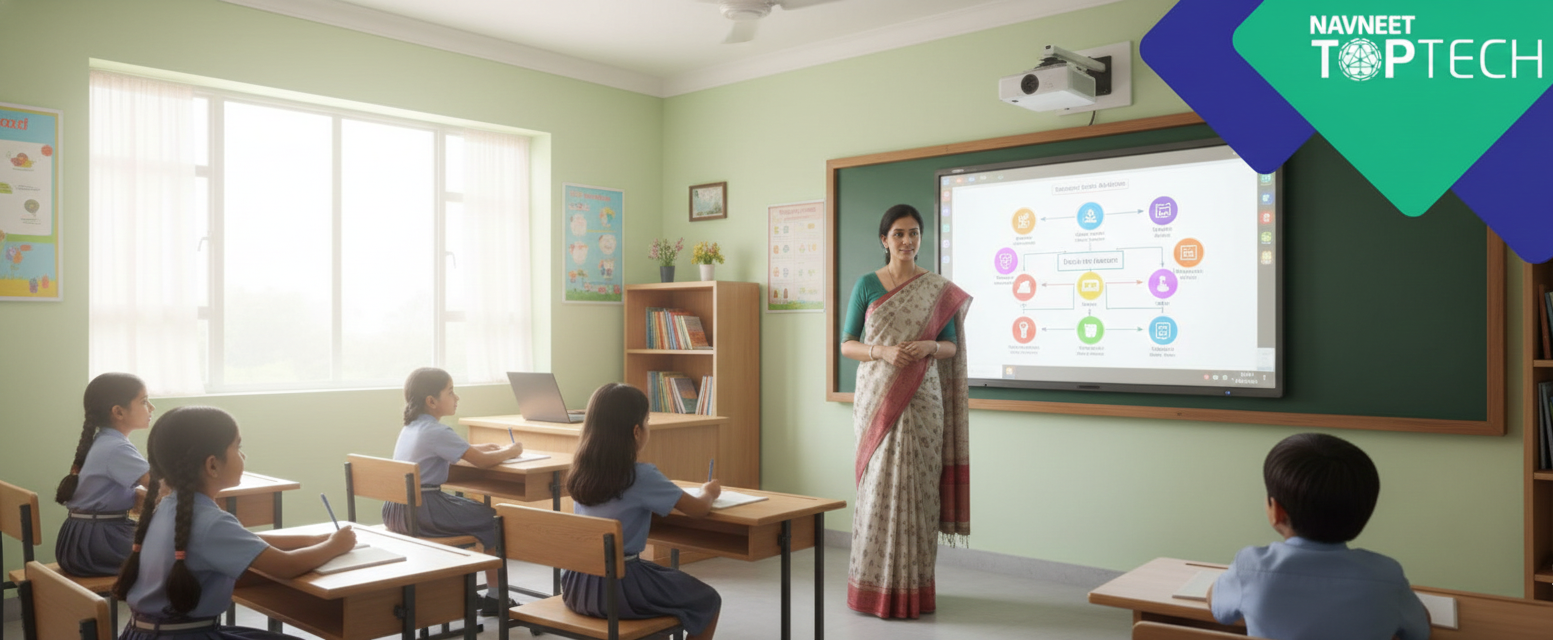Managing student attendance has evolved far beyond just marking presence; it’s now a live indicator of student engagement, communication, and institutional accountability. The Ministry of Education’s Pan‑India Vidya Samiksha Kendra initiative further strengthens the shift from passive record‑keeping to active monitoring of school attendance data at the national level. The initiatives reflect how attendance data is increasingly tied to decision-making, policy implementation, and student outcomes.
However, with so many digital solutions in the market, choosing the right student attendance software for your school in 2025 requires both clarity and care. This guide will walk you through the key steps to identify, evaluate, and adopt a solution that fits your school’s operational needs and future aspirations
Why Choosing the Right Attendance Software for Schools Matters in 2025

As said, today’s schools are more connected, data-aware, and parent-inclusive than ever before. The right student attendance management system should not only save time but also support broader educational workflows. Here’s why making the right choice matters:
1. Real-time visibility into student presence
Teachers and administrators can get a live view of attendance across classrooms, labs, or remote sessions. They can also track patterns like frequent late arrivals or unexplained absences and step in at the right time to support the student.
2. Reduced manual errors and administrative load
A digital system reduces errors like missed entries or duplicate records during the consolidation process, saving time for teachers and staff during busy school hours.
3. Stronger communication with parents
When a student is marked absent or late, parents can be notified immediately through SMS or app alerts. This keeps families informed and reduces uncertainty, especially in schools with younger students or larger batches.
4. Integrated data for better decision-making
Attendance data, when linked with academic or behavioural records, gives a more complete picture of student engagement. Schools can spot when a drop in attendance aligns with learning gaps and respond with the right kind of support.
5. Improved compliance and audit readiness
Digital records are easy to store, sort, and retrieve when required for inspections, audits, or internal reports. It also ensures the data is consistent across months or academic terms.
6. Enabling digital-first, flexible learning ecosystems
Modern attendance systems lay the groundwork for long-term digital transformation while supporting today’s need for flexible, hybrid, and personalised learning models. By integrating seamlessly with LMS platforms, timetabling tools, and cloud-based academic workflows, they don’t just record presence; they create a dynamic infrastructure that adapts to evolving classroom formats, remote learning, and multi-campus coordination. It consolidated the process into a unified system while keeping day-to-day processes structured and familiar.
These features are no longer add-ons. They are expected standards in any modern attendance tracking solution.
Step-by-Step Guide to Choosing the Best Student Attendance Software for Schools in 2025
Choosing the right platform involves understanding your school’s needs, evaluating tools with the right criteria, and making a decision rooted in both data and practicality. Here’s how to approach the process:
1. Define Your Requirements Clearly
Before reviewing vendors, outline what your school needs from an attendance tracking system. Consider:
- Total number of students and classes to be covered
- Preferred method of attendance (mobile app, web dashboard, RFID, biometric, facial recognition)
- Requirement for offline or low-connectivity compatibility
- Integration with your school’s existing systems (ERP, LMS, parent portal)
- Administrative access controls and reporting requirements
- Parent-teacher communication features
Being precise at this stage helps you eliminate tools that may look impressive but don’t match your actual needs.
2. Shortlist Trusted Software Solutions
Look for providers that have a proven track record in the education sector. Some signals to watch for:
- Presence in other reputed schools or institutions
- Transparent onboarding process and documented case studies
- Certifications or industry recognitions
- Depth of features that are specifically tailored for school workflows
You may also want to check if the platform is built specifically for education or adapted from a generic HR or workforce management solution.
3. Ask for Live Demos and Free Trials
A live walkthrough gives you visibility into how the system handles real-time use cases — from marking attendance to generating reports. Free trials also help your staff get familiar with the dashboard and flag early usability issues.
- Make sure both the administrative staff and the teachers try the system during this phase
- Check if the parent view is intuitive and aligned with your communication goals
- Observe how quickly users can complete routine actions like marking or correcting attendance
4. Evaluate Support and Training Resources
A good product should come with dependable support. Consider:
- What kind of onboarding and training is provided?
- Are user manuals, help centers, or how-to videos available?
- Is multilingual or regional support needed for your school’s context?
- How easy is it to raise a ticket or get on a support call?
Even the best student attendance management system needs a responsive team behind it to truly work well in real-world conditions.
5. Compare Pricing and Features
Cost is important, but it should be viewed with value, not just features. Look for:
- Transparent pricing models (monthly, yearly, or per student)
- Inclusion of updates, support, and training in the plan
- Feature comparisons with competitors to ensure you’re not missing critical tools
- Any hidden costs related to integrations or premium features
It’s useful to maintain a simple comparison sheet that weighs price against functionality, support, and user experience.
6. Check Real User Reviews
Independent reviews are one of the strongest indicators of product reliability. Explore:
- Google and G2 reviews for recent user experiences
- YouTube walkthroughs or testimonials that show product usage
- Case studies from similar-sized schools
- Social media mentions that reflect long-term satisfaction
Ask the provider to connect you with a current client so you can get candid feedback.
7. Make a Data-Driven Decision
Once you’ve gathered all inputs, build a simple scoring sheet across key metrics:
- Feature match
- Ease of use
- Cost efficiency
- Customer support
- Feedback from school staff
Bringing structure to the final evaluation reduces subjectivity and creates buy-in across stakeholders. This ensures the system you choose is not only technically sound but also embraced by the people who will use it daily.
Common Mistakes to Avoid While Choosing
Here are a few things to keep in mind during the decision-making process
1. Set your priorities
Don’t prioritise cost at the expense of usability or long-term value. A lower-cost tool might seem appealing upfront, but if it slows down your staff or misses key features, it could lead to frustration and rework down the line.
2. Check for interoperability
Ensure the software integrates smoothly with your existing ERP or timetable systems. Poor compatibility can surface later, and your team may end up juggling multiple disconnected systems.
3. Plan for training and support
Even user-friendly, intuitive tools may need onboarding training. Select a provider that offers demos, documentation, and responsive support, particularly during setup and initial use.
4. Include teachers and ground staff in the trial phase
Teachers, coordinators, and support staff interact with the system daily and thus should be part of the evaluation process. Their input helps surface practical needs early, ensuring the solution works in real classrooms.
5. Confirm how student data will be handled
Attendance records carry sensitive information about students. Verify whether the provider has implemented proper access controls and effective privacy protocols.
Top Recommended Student Attendance Management Systems (2025)
While there are many attendance tracking solutions available on the market, certain platforms have stood out for their education-first design and performance. A trusted name in the education ecosystem, NAVNEET TOPTECH offers a student attendance management system that is purpose-built for Indian schools. Its platform is designed to be easy for teachers, insightful for administrators, and reassuring for parents.
Key features include:
- Mobile and web-based attendance tracking
- Instant parent notifications
- Custom report generation
- Multi-language support
- Seamless integration with school ERP systems
With a focus on reliability and regional context, it is a strong contender for schools looking to adopt a dependable solution in 2025. The platform brings together intuitive design, real-time tracking, and seamless ERP integration. You can visit NAVNEET TOPTECH to explore how their Top LMS platform can support your school’s needs.
A Forward Step for Future-Ready Schools
Choosing the right attendance software reflects a school’s intent to be more responsive, transparent, and aligned with the expectations of today’s learning environments. Attendance tools, when thoughtfully chosen, support schools in becoming more agile and better prepared for the evolving educational landscape.
The right choice, made with clarity, sets the foundation for a school that moves forward with confidence.
Frequently Asked Question
1. How does attendance software help with school compliance?
Attendance software with compliance features ensures accurate record-keeping, audit-ready reports, and alignment with national or state education regulations, reducing administrative errors.
2. Can attendance software track remote or online classes?
Yes, most student attendance tracking software supports hybrid learning, allowing schools to mark attendance for online classes, live sessions, or virtual labs.
3.How can attendance software improve student engagement? What is the best mobile app for student attendance?
By monitoring attendance patterns, schools can quickly identify students at risk of absenteeism and take proactive steps to boost participation and learning outcomes.
4. Can school attendance software track teacher attendance as well?
Yes. Many modern student attendance systems offer teacher attendance tracking in addition to student attendance, providing unified school management and reporting.




